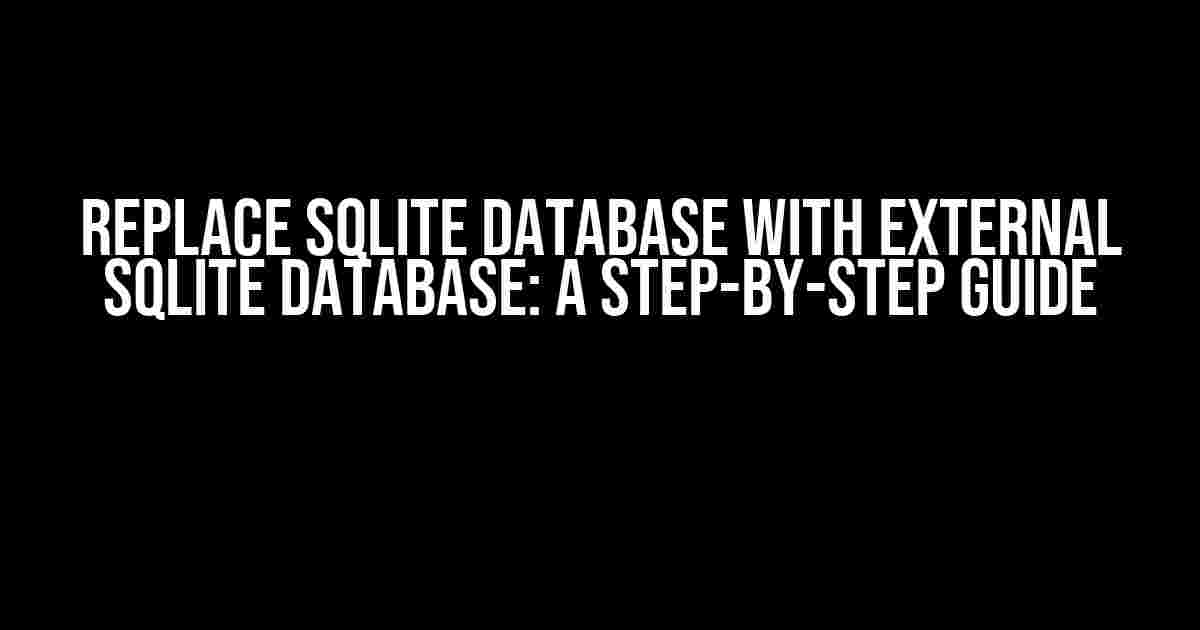Are you tired of dealing with the limitations of the default SQLite database in your application? Do you want to take your database to the next level by using an external SQLite database? Look no further! In this article, we’ll show you how to replace your default SQLite database with an external SQLite database in a few easy steps.
Why Use an External SQLite Database?
Before we dive into the tutorial, let’s talk about why you might want to use an external SQLite database in the first place. Here are a few compelling reasons:
- Scalability**: An external SQLite database can handle larger datasets and more concurrent connections than the default SQLite database.
- Flexibility**: With an external SQLite database, you can use SQL statements that aren’t supported in the default SQLite database, such as foreign key constraints and triggers.
- Security**: By storing your database in a separate file, you can implement additional security measures, such as encryption and access controls.
- Maintainability**: Having a separate database file makes it easier to manage and maintain your data, as you can easily back up and restore your database.
Step 1: Create a New SQLite Database File
The first step is to create a new SQLite database file that will serve as your external database. You can do this using the SQLite command-line tool or a GUI tool like DB Browser for SQLite.
# Create a new SQLite database file called "mydatabase.db" sqlite3 mydatabase.db
Step 2: Design Your Database Schema
Next, you’ll need to design your database schema, which includes the tables, columns, and relationships between them. You can use a tool like DB Browser for SQLite to create your schema visually, or you can use SQL statements to create your tables and columns.
# Create a table called "users" with three columns: "id", "name", and "email" CREATE TABLE users ( id INTEGER PRIMARY KEY, name TEXT NOT NULL, email TEXT NOT NULL );
Step 3: Populate Your Database with Data
Now that you have a new SQLite database file and a database schema, it’s time to populate your database with data. You can do this by inserting data into your tables using SQL statements or by importing data from a CSV file.
# Insert a new row into the "users" table
INSERT INTO users (name, email) VALUES ('John Doe', '[email protected]');
Step 4: Configure Your Application to Use the External Database
The final step is to configure your application to use the external SQLite database instead of the default database. This will vary depending on the programming language and framework you’re using, but here are some general steps:
- Import the necessary SQLite library or module in your application code.
- Establish a connection to the external SQLite database file using the library or module.
- Use the connection to execute SQL statements and interact with the database.
Here’s an example in Python using the sqlite3 library:
import sqlite3
# Establish a connection to the external SQLite database file
conn = sqlite3.connect('mydatabase.db')
# Create a cursor object to execute SQL statements
cursor = conn.cursor()
# Execute a SQL statement to retrieve all rows from the "users" table
cursor.execute('SELECT * FROM users')
# Fetch all rows from the result set
rows = cursor.fetchall()
# Print the rows
for row in rows:
print(row)
# Close the connection
conn.close()
Troubleshooting Common Issues
By following these steps, you should be able to replace your default SQLite database with an external SQLite database. However, you may encounter some common issues along the way:
| Issue | Solution |
|---|---|
| Database file not found | Make sure the database file is in the correct location and that the file path is correct. |
| Permission denied | Make sure the user or application has the necessary permissions to read and write to the database file. |
| SQL syntax error | Check the SQL statement for syntax errors and make sure it’s compatible with the SQLite version you’re using. |
Conclusion
Replacing your default SQLite database with an external SQLite database is a straightforward process that can provide numerous benefits, including scalability, flexibility, security, and maintainability. By following these steps, you can take your database to the next level and unlock new possibilities for your application.
Remember to design your database schema carefully, populate your database with data, and configure your application to use the external database. If you encounter any issues, refer to the troubleshooting section for common solutions.
Now, go forth and create amazing applications with your new external SQLite database!
Frequently Asked Question
Got questions about replacing SQLite database with an external SQLite database? We’ve got the answers!
Why would I want to replace my app’s SQLite database with an external SQLite database?
Replacing your app’s internal SQLite database with an external one can provide more flexibility and scalability. For instance, you can store a large amount of data without worrying about device storage limitations, or easily sync data across multiple devices.
How do I connect my app to an external SQLite database?
To connect your app to an external SQLite database, you’ll need to use a URI scheme that points to the external database file. You can do this by using the `javax.uri` package in Java or the `swift` framework in iOS.
What are the security implications of using an external SQLite database?
When using an external SQLite database, you’ll need to ensure that your app properly authenticates and authorizes access to the database. You should also consider encrypting data in transit and at rest to protect sensitive information.
Can I use an external SQLite database with a cloud-based service?
Yes, you can use an external SQLite database with a cloud-based service like AWS, Google Cloud, or Microsoft Azure. This allows you to store and manage your app’s data in the cloud, and access it from anywhere.
How do I migrate my app’s data from an internal SQLite database to an external one?
To migrate your app’s data, you’ll need to export the data from the internal database, and then import it into the external database. You may need to use a migration tool or script to handle the transfer process.



